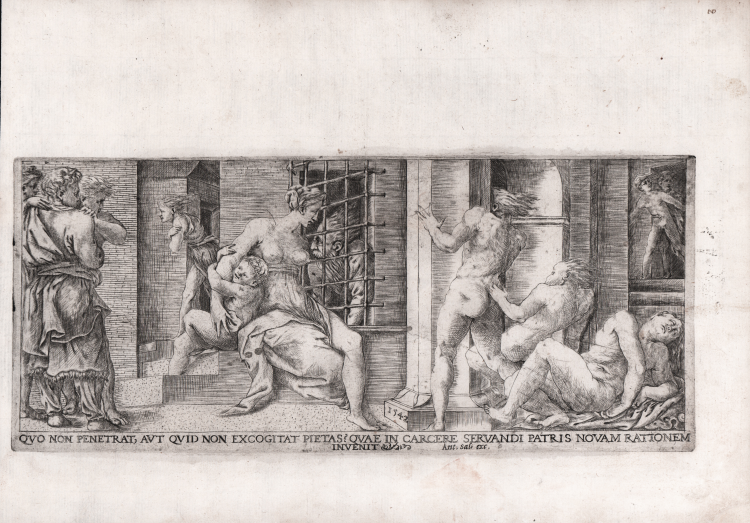




| Reference: | S30761 |
| Author | Georges Reverdy [Giorgio Reverdino] |
| Year: | 1542 ca. |
| Measures: | 320 x 415 mm |



| Reference: | S30761 |
| Author | Georges Reverdy [Giorgio Reverdino] |
| Year: | 1542 ca. |
| Measures: | 320 x 415 mm |
The daughter of Cimon supports the father prisoner.
Engraving, 1542, dated on plate at lower center. After Rosso Fiorentino.
Example of the second state of two, with the address of Antonio Salamanca.
A fine impression, on contemporary laid paper with “shield with letter M and star” watermark, unusual wide margins, perfect conditions.
Pero, who secretly breastfeeds her father, Cimon, after he is incarcerated and sentenced to death by starvation. She is found out by a jailer, but her act of selflessness impresses officials and wins her father's release.
After the stucco relief under Rosso Fiorentino's fresco representing Cleobis and Biton in the Galerie Francois I at Fontainebleau. Carroll in Washington 1987 supposes that it was not made directly after the stucco, and because even the figures in the print that are absent from the stucco are very similar to Rosso's manner, the print was most probably made after a lost drawing by him. Carroll rejects Bartsch's attribution to Georges Reverdy, and also Zerner's suggestion of 1972 that its manner was close to Domenico del Barbiere. Massari suggests the attribution to Giulio Bonasone.
The subject, known since the last quarter of the 15th century as " RomanCharity," is based on a text of Valerius Maximus, "Factorum et Dictorum Memorabilium Libri IX," but refers to an earlier legend which appeared at Rome at the beginning of the 2nd century BC, in connection with the construction of a temple dedicated to Pietas (Charity), a temple dedicated to Pietas, later replaced by the Church of St. Nicholas in Prison. In the seventeenth and eighteenth centuries, many European artists depicted the scene.
Georges Reverdy (1529 fl. - 1564/5 died, also known as Reverdy, Georges; Reverdinus, Cesare; Reverdino, Gaspar) was an engraver. Probably of origins in Piedmont, documented in Lyons from 1529 to 1565, in the last of which he is described as dead. Since his last dated print is from 1564, he probably died the previous year. Wrongly catalogued by Bartsch. It is possible, however, that he went to Italy around 1530, making engravings of religious scenes.
A fine example of this rare work.
Ex collection Benedic Penon (Lugt, 3830).
Bibliografia
Bartsch, XV.487.2; Borea, Il Primato del Disegno, p. 261 n. 664; Eugene A. Carroll, Drawings, Prints, and Decorative Arts, Washington, National Gallery of Art 1987, 81; Massari, Iulio Bonasone, p. 34, 5; Henri Zerner, 440.
Georges Reverdy [Giorgio Reverdino] (Attivo 1529 – 1557)
|
Giorgio Reverdino (also known with the French name of Georges Reverdy) was an artist of Italian origin and particularly active in France. A painter and especially a copperplate engraver and xylographer, mistakenly believed to be of Venetian, Paduan, Bolognese, or French origin, he was also called Cesare or Gaspare. Probably born in Piedmont, in Chivasso, he perhaps learned the practice of engraving in Rome, at the workshop of Marcantonio Raimondi. From 1528 to his death, he was active in Lyon, where he left a series of woodcuts for books and engravings with burin, many of them signed or monogrammed, of uneven quality.
Scholars have always been divided on the origin of this particular artist; the fact that Reverdy was originally from Piedmont is certified in the essay by Alessandro Baudi di Vesme, who points out that as early as the Premier volume de la Bibliotheque du sieur de la Croix du Maine, published in Paris in 1584 and dedicated to Henry III, King of France, we read, “Georges Reverdy Piedmontois, excellent graveur au burin.. florissait à Lyon l'an 1555”. Again, Baudi di Vesme points out that Chivasso was the probable city of origin of Reverdy.
|
Georges Reverdy [Giorgio Reverdino] (Attivo 1529 – 1557)
|
Giorgio Reverdino (also known with the French name of Georges Reverdy) was an artist of Italian origin and particularly active in France. A painter and especially a copperplate engraver and xylographer, mistakenly believed to be of Venetian, Paduan, Bolognese, or French origin, he was also called Cesare or Gaspare. Probably born in Piedmont, in Chivasso, he perhaps learned the practice of engraving in Rome, at the workshop of Marcantonio Raimondi. From 1528 to his death, he was active in Lyon, where he left a series of woodcuts for books and engravings with burin, many of them signed or monogrammed, of uneven quality.
Scholars have always been divided on the origin of this particular artist; the fact that Reverdy was originally from Piedmont is certified in the essay by Alessandro Baudi di Vesme, who points out that as early as the Premier volume de la Bibliotheque du sieur de la Croix du Maine, published in Paris in 1584 and dedicated to Henry III, King of France, we read, “Georges Reverdy Piedmontois, excellent graveur au burin.. florissait à Lyon l'an 1555”. Again, Baudi di Vesme points out that Chivasso was the probable city of origin of Reverdy.
|